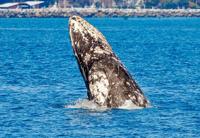Since 2019, Dana Point has been trademarked as the “Dolphin & Whale Watching Capital of the World,” thanks to the work of two women who own whale-watching tour companies in the harbor. The honor of this title has been shown off in the past couple of weeks with the increase of sightings of all different types of whales and dolphins along the coast.
Throughout the persistence of inclement bad-weather weekends this past month, Dana Wharf Sportfishing and Whale Watching and Captain Dave's Whale Watching Safari have given tours a fantastic viewing experience of why Dana Point is the best year-round spot to see the local ocean residents.
“We are the real deal here at Dana Point,” said Donna Kalez, Chief Operating Officer of Dana Wharf Sportfishing and Whale Watching. “It's a great time to get out on the water and go whale watching even if a lot of people have been hunkered in their houses waiting for the storms to pass. But it's beautiful out on the water, and we have been able to see whales that were just about half a mile to a mile off our shore.”
There is an excellent array of whale and dolphin species that are seen at different points in time over the year. Currently, many Fin Whales, some with calves, are being seen, along with Gray Whales and Minke Whales.
Dana Point waters see about 40-50 whales daily during peak migration season. The migration of the Gray Whale begins in December and continues through March as they travel from feeding grounds in the Bering Sea to warmer waters in Baja, where most calves are born.
Experts believe Gray Whales travel so closely to the Dana Point shoreline because the Dana Point Headlands are a landmark for their journeys. The abundance of sightings inspired the annual Festival of Whales, the longest-running celebration of the Gray Whale. The festival celebrated its 48th year in March, drawing thousands of visitors.
Other whale species, including Blue Whales, Fin Whales, Humpback Whales, and Minke Whales, can be seen year-round. There is also a local population of about 450,000 dolphins—more dolphins per square mile than anywhere else in the world. Sightings of the “dolphin stampede,” the phenomenon of a massive dolphin pod traveling at high speeds by diving in and out of the water, have also put Dana Point on the map.
“It's phenomenal, and it's just off the charts,” said Gisele Anderson of Captain Dave's Whale Watching Safari. “There are people that come from all over the world to see Fin Whales and people who come from all over the world to see the Blue Whales, and they come here to Dana Point to do it.”
Both companies record daily whale and dolphin sighting logs that can be viewed to see what is being seen throughout every trip of the day.
“In one trip, we'll see four kinds of whales, so you just don't get that in other places in the world,” Anderson said. “I've traveled to some of the best whale watching places in the world, and you just don't get that elsewhere. Nothing rivals Dana Point; we are unbeatable, and I'm pretty proud of it. It's a gift to be able to encounter these animals in the wild.”
For four years now, The World Cetacean Alliance has recognized Dana Point and its trademarked name as the first and only Whale Heritage Site in the Americas. The criteria for acceptance into the alliance are incredibly challenging, focusing on protection, sustainability, education, research, public access, and awareness and requiring a community effort that furthers the purpose of a Whale Heritage Site.
“We couldn't be prouder to be a Whale Heritage Site, because Whale Heritage Sites aren't just a designation that says, ‘Hey, this is a fabulous place to see the animals.’ It's way more than that and is so much deeper,” Anderson said. “It says that this is a place that's passionate about whales, it celebrates them, protects them, and it has conservation in place.”
“It's a whole broad, rich spectrum of events that say that this is a place that's passionate about dolphins and whales, and I couldn't be prouder that our home is that place. It was also the first one in the Americas to get this designation.”


